|
A-bombed
Ginkgo trees in Hiroshima, Japan
+ documentary film
At the end of World War II on August 6, 1945 an atomic bomb was dropped on Hiroshima by the Americans. The plants and trees in the area around the epicentre were examined in September 1945. Among the survivors were the six Ginkgo biloba trees shown on this page. They were situated near the blast center and appeared to bud after the blast without major deformations and are still alive today.
Therefore the Ginkgo is regarded as the 'bearer of hope'.
.
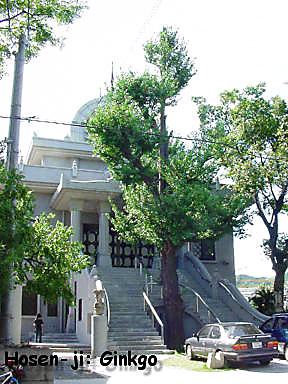
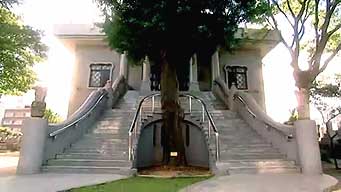 |
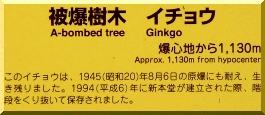
HOSEN-JI This Ginkgo
situated near a temple about 1130 m away from the hypocenter appeared to
bud after the blast (the temple itself was destroyed). The temple-site
in Housenbou was smaller after the war and they considered transplanting
or cutting down the Ginkgo to rebuild the temple. In 1994 it was decided
to leave it there and adjust the temple to it, so now the main building
has stairs in front divided into left-and right hand sides, protecting
the Ginkgo inside this U-shape. Engraved on it "No more Hiroshima" and
people's prayers for peace. This tree has thus become an international
symbol. Estimated planting 1850, 15 m.
Location:
3-3 Tera-machi, Naka-ku. Near Nishihongan-ji and Zensho-ji. Close to Betsuin-mae
streetcar stop on line 8 to Yokogawa JR station.
|
.
.
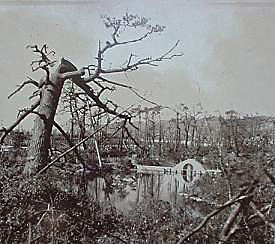
Ginkgo at Shukkeien garden in 1945 |
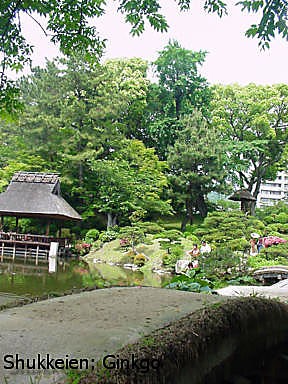 |
 |
SHUKKEIEN
Ginkgo at Shukkeien garden (founded
in 1620), 1370 m from the blast.
Read more about a sapling of this tree planted at UNITAR Geneva in 2016 on my website and blog. Just a short walk from JR Hiroshima Station;
in the garden right of the pond, near low bridges.
|
.
.
 |

JOSEI-JI Ginkgo at
Josei-ji (temple), 1420 m from the blast. Location:
15-22 Sumiyoshi-cho, Naka-ku.
|
.
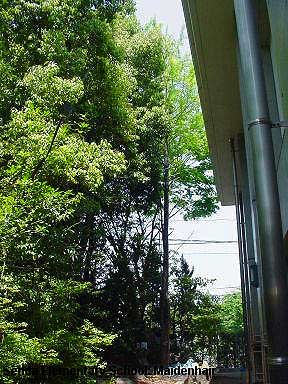
|
Ginkgo at
Senda Elementary School, 1650 m from the blast.
Location:
near Miyukibashi (bridge) which was made famous by the well-known A-bomb
photo, and Senda Park.
|
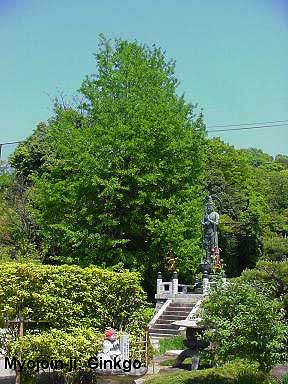 |

MYOJOIN-JI Ginkgo at
Myojoin-ji (temple), 1780 m from the blast.
Location:
between Tsuruhane-jinja and Nijistu-jinja. North of Hiroshima JR station
and near Tokiwa-bashi Bridge. 2-6-25 Futaba-no-sato 2 chome, Higashi-ku.
|
.
 |

ANRAKU-JI Ginkgo at
Anraku-ji (temple), 2160 m from the blast. The temple was restored in 1948.
A hole was made in the roof to create space for the tree to grow. This
Ginkgo has grown from a cutting taken from a 12th century tree at Zenpuku-ji
Temple in Tokyo. The cutting was taken to Hiroshima during the Edo period.
Location:
1-5-20 Ushita-honmachi, Higashi-ku
|
.
Watch this documentary film about A-bombed Ginkgo trees in Hiroshima.
Documentary by France5

With thanks to Mandy Conti for giving me permission to show you these photos.
© Cor
Kwant
Copyright
information.